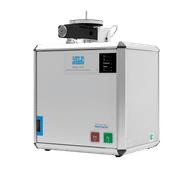New polymer mixture creates ultra-sensitive heat sensor
Polymer gels with tunable ionic Seebeck coefficient for ultra-sensitive printed thermopiles
Scientists at the Laboratory of Organic Electronics have developed an ultra-sensitive heat sensor that is flexible, transparent and printable. The results have potential for a wide range of applications - from wound healing and electronic skin to smart buildings.

Research fellow Dan Zhao with the printable ultra-senstive sensor.
Peter Holgersson
The ultra-sensitive heat sensor is based on the fact that certain materials are thermoelectric. The electrons in a thermoelectric material move from the cold side to the warm side when a temperature difference arises between the two sides, and a voltage difference arises. In this present project, however, the researchers have developed a thermoelectric material that uses ions as charge carriers instead of electrons, and the effect is a hundred times larger.
A thermoelectric material that uses electrons can develop 100 μV/K (microvolt per Kelvin), which is to be compared with 10 mV/K from the new material. The signal is thus 100 times stronger, and a small temperature difference gives a strong signal.
The results from the research, carried out by scientists at the Laboratory of Organic Electronics at Linköping University, Chalmers University of Technology, Stuttgart Media University and the University of Kentucky, have been published in Nature Communications.
Dan Zhao, research fellow at Linköping University and one of three principal authors of the article, has discovered the new material, an electrolyte that consists of a gel of several ionic polymers. Some of the components are polymers of p-type, in which positively charged ions carry the current. Such polymers are well-known from previous work. However, she has also found a highly conductive polymer gel of n-type, in which negatively charged ions carry the current. Very few such materials have been available until now.
With the aid of previous results from work with electrolytes for printed electronics, the researchers have now developed the first printed thermoelectric module in the world to use ions as charge carriers. The module consists of linked n- and p-legs, where the number of leg connections determines how strong a signal is produced. The scientists have used screen printing to manufacture a highly sensitive heat sensor, based on the different and complementary polymers. The heat sensor has the ability that convert a tiny temperature difference to a strong signal: a module with 36 connected legs gives 0.333 V for a temperature difference of 1 K.
"The material is transparent, soft and flexible and can be used in a highly sensitive product that can be printed and in this way used on large surfaces. Applications are found within wound healing, where a bandage that shows the progress of the healing process is used, and for electronic skin", says Dan Zhao.
Another possible application is in temperature exchange in smart buildings.
Original publication
Other news from the department science
These products might interest you

CHSN-O, CN and N Elemental Analyzers by Velp Scientifica
State-of-the-art Elemental Analyzers for N, CN and CHSN-O in organic samples
Consistency, ease of use, and premium features for elemental analysis following official standards

HYPERION II by Bruker
FT-IR and IR laser imaging (QCL) microscope for research and development
Analyze macroscopic samples with microscopic resolution (5 µm) in seconds

Get the analytics and lab tech industry in your inbox
By submitting this form you agree that LUMITOS AG will send you the newsletter(s) selected above by email. Your data will not be passed on to third parties. Your data will be stored and processed in accordance with our data protection regulations. LUMITOS may contact you by email for the purpose of advertising or market and opinion surveys. You can revoke your consent at any time without giving reasons to LUMITOS AG, Ernst-Augustin-Str. 2, 12489 Berlin, Germany or by e-mail at revoke@lumitos.com with effect for the future. In addition, each email contains a link to unsubscribe from the corresponding newsletter.























































